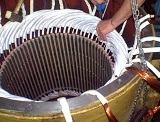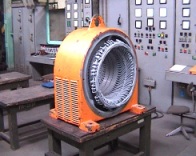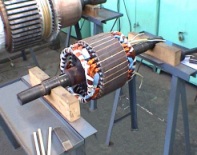The most common malfunctions and repairs of synchronous machines
 Increased heating of the active steel of the stator. Heating of the active steel of the stator can occur due to overloading of the synchronous machine, as well as short-circuiting in the charge sheets of the core with weak pressing at the factory. With a slight compression of the core, the micro-movement of the charge sheets occurs with a magnetization reversal frequency of 100 Hz / s, as well as with increased vibration of the active steel.
Increased heating of the active steel of the stator. Heating of the active steel of the stator can occur due to overloading of the synchronous machine, as well as short-circuiting in the charge sheets of the core with weak pressing at the factory. With a slight compression of the core, the micro-movement of the charge sheets occurs with a magnetization reversal frequency of 100 Hz / s, as well as with increased vibration of the active steel.
In the process of vibration of active steel, wear of the sheet insulation occurs. Sheets with damaged insulation are in contact with each other and in the resulting uninsulated steel package eddy currents heat the core. In this case, an extended short circuit across the entire stator bore or a local shutdown may occur.
Depending on the area of short circuit in the sheets, the so-called can occur. "Fire in iron", which greatly overheats the insulation and leads to its damage. This phenomenon is dangerous in large synchronous machines, especially turbine generators.
Get rid of such a dangerous phenomenon in active steel as follows:
• large synchronous machines have current and power meters (ammeters and wattmeters) so the load level is easily monitored and load reduction measures can be taken quickly. The heating of the winding and active steel is controlled by thermocouples built into the stator to measure the temperature of the winding and core;
• in the case of a short circuit of active steel, especially of a local nature, this phenomenon is detected in a working machine only by ear. An itchy vibration occurs and is heard approximately in the stator where the active steel is enclosed. To eliminate this phenomenon, the machine must be disassembled. Usually, large synchronous motors are made with extended shafts, which makes it possible to remove the shields and move the stator where you can work.
Then, to seal the steel, textolite wedges smeared with one of the adhesive varnishes (No. 88, ML-92, etc.) are driven into the teeth. Before the teeth are driven in, the active steel is thoroughly blown with dry compressed air.
If for some reason there is a short circuit and melting of iron in the teeth, the damaged areas are carefully cut out, cleaned, air-dried varnish is poured between the sheets and the sheets are wedged. If after this the vibration of the itch does not disappear, the wedging should be repeated until the vibration of the active steel completely disappears.
In large high-voltage machines, the quality of repair and lining of sheets is checked by the induction method.
 Overheating of the stator winding.The most common cause of local overheating of the stator windings of synchronous machines is short circuits per turn. If a turning fault occurs in the bitumen-mixed stator winding, the machine will shut down with maximum protection due to an increase in current in the faulted phase. At the location of the turn circuit, the bitumen will melt, flow between the turns and insulate them. Approximately 30-40 minutes after the bitumen has hardened, the synchronous machine should be started. Long-term experience confirms the favorable result of the described procedure for removing coil damage.
Overheating of the stator winding.The most common cause of local overheating of the stator windings of synchronous machines is short circuits per turn. If a turning fault occurs in the bitumen-mixed stator winding, the machine will shut down with maximum protection due to an increase in current in the faulted phase. At the location of the turn circuit, the bitumen will melt, flow between the turns and insulate them. Approximately 30-40 minutes after the bitumen has hardened, the synchronous machine should be started. Long-term experience confirms the favorable result of the described procedure for removing coil damage.
However, such restoration of the stator insulation cannot be considered reliable, although the restored insulation can work reliably for a long time until the motor is stopped for regular repairs.
In the stator windings of synchronous machines, faults similar to faults in the windings of asynchronous motors are possible, such as overcurrent when the mains voltage drops. In this case, it is necessary to increase the mains voltage to the nominal one.
Excitation coil overheating. Unlike the stator winding of synchronous machines, the field windings are supplied with direct current. By varying the excitation current in a synchronous machine, the power factor can be adjusted. The excitation current is regulated within the nominal values for each type of synchronous machine.
As the field current increases, the overload capacity of synchronous motors increases, the power factor improves due to the high compensating capabilities of such machines, and the voltage level in the area of their operation increases.However, as the current in the field winding increases, the heating of that winding increases, and the current in the stator winding also increases. Therefore, the field winding current is regulated to such a level that the stator winding current becomes minimum, the power factor is equal to unity, and the field current is within the rated value.
When the field coil circuit is closed, the coil temperature rises, overheating may be unacceptable; rotor vibration occurs, which can be stronger, most of the coil turns are closed.
The possibility of a short circuit in the field winding is explained as follows. As a result of the drying and shrinking of the insulation of the coils of the poles, movement of the coils occurs, in connection with this, the insulation of the housing and the turn wears out, which in turn creates conditions for the occurrence of a short circuit between the turns and on the pole housing.
 Field winding failure when starting synchronous motors. Sometimes there is a breakdown of the insulation of the excitation winding of synchronous motors at the initial moment of starting. When the field winding is closed to the case, the operation of the synchronous motor is inadmissible.
Field winding failure when starting synchronous motors. Sometimes there is a breakdown of the insulation of the excitation winding of synchronous motors at the initial moment of starting. When the field winding is closed to the case, the operation of the synchronous motor is inadmissible.
In order to understand the causes of malfunctions in the process of starting synchronous motors, it is necessary to know their structure.
The stator and windings of a synchronous motor are similar in construction to the stator of an induction motor. Synchronous motor differs from induction rotor design.
The rotor of a synchronous motor with a rotation speed of up to 1500 rpm has a convex pole, i.e. the poles are reinforced on a rotor star (rim). The rotors of high-speed machines are made implicitly. In the poles, copper or brass rods of the starting winding are inserted into the stamped holes. Coils with field windings connected in series with each other are mounted on the poles (on top of the casing insulation).
Normally, a synchronous motor with a starting coil is started in asynchronous mode. If the excitation winding of a synchronous motor is blind connected to the exciter, then the intermediate circuit exciting apparatus not necessarily; the machine is brought into synchronism by being excited by a permanently connected exciter to the field winding.
However, there are schemes, especially in large machines, when the excitation is supplied from a separately installed exciter through a switching device-contactor, usually three-pole. Such a contactor has the following kinematics: two poles with normally open contacts and the third with a normally closed contact. When the contactor is on, a normally closed contact opens only when the normally open contacts close, and vice versa, they open when the normally closed contact closes. When adjusting the contacts, the order of their closing and opening must be strictly observed.
Such demands on the field supply contactor are due to the fact that if, when the motor is started, the normally open contact of the contactor, through which the field winding is closed to resistance, turns out to be open, the insulation of the coils will be damaged on the housing. This is explained as follows.
At the moment of switching on, the rotor is stationary and the machine is a transformer, the secondary winding of which is an exciting winding, at the ends of which a voltage, proportional to the number of turns, can reach several thousand volts and break through the insulation on the casing. In this case, the car is dismantled.
If the synchronous motor is made with an extended shaft, the stator is moved, the damaged pole is removed and the damaged casing insulation is repaired. The post is then installed in place, after which the insulation resistance to the housing is checked with a megohmmeter; the absence of short-circuiting of a turn in the rest of the excitation winding by applying an alternating voltage to the slip rings. In the event of a short circuit on a turn, this part of the winding will heat up. The short circuit can be easily found.
Faults in the brush assembly and slip rings. During the operation of synchronous motors, malfunctions occur in the device of the brush and slip rings for various reasons. The main ones are the following.
Intense wear of the ring at the negative pole is due to the transfer of metal particles to the brush. When the sliding ring wears, deep grooves appear on its surface; brushes wear out quickly; it is not possible to place the new brush correctly on the ring when replacing. To limit ring wear, the polarity should be changed (ie the cable connection to the brush holder stroke should be reversed) at intervals of once every 3 months.
As a result of electrochemical phenomena under the action of a current from a galvanic pair, when the brush touches a stationary ring in a humid atmosphere, rough spots appear on the surface of the rings, as a result of which during the operation of the machine, the brushes are activated intensively and spark . Removal: grind and polish the rings.
To avoid stains on the surface of the rings in the future, a pressboard gasket is placed under the brushes (during long-term parking of the machine).
Upon inspection of the brush apparatus, it appears that some of the brushes in the brush holder brackets tighten without touching the slip rings and are not engaged. Brushes remaining in operation, overloaded, spark and heat up, that is, they wear intensively. A possible reason may be the following: the brushes are tightly placed in the holders of the brush holders, without tolerances; contamination, jamming of the brushes, causing them to hang in the clips; weak pressure on the brushes; poor ventilation of the brush apparatus; brushes with high hardness and high coefficient of friction are installed.
Protective equipment: brushes must comply with the recommendations of the machine manufacturer; new brushes should fit into the holder of the brush holders with a gap of 0.15-0.3 mm; the pressure on the brush is adjusted in the range of 0.0175-0.02 MPa / cm2 (175-200 g / cm2) with a permissible pressure difference within 10%; the brush apparatus, the insulation of the rings must be kept clean by periodically blowing with dry compressed air; the allowable slip ring surface runout should be within 0.03-0.05mm.
Faults in the rotor starting cell.
The starting cage of the rotor (winding) (similar to the squirrel cage of asynchronous motors) is an integral part of synchronous motors and is designed to start them in asynchronous mode.
The starting cell is in hard starting mode, it is heated to a temperature of 250 ° C. When the rotation speed reaches 95% pn, a direct current is supplied to the excitation coil, the rotor is completely synchronized with the rotating floor of the stator and the mains frequency. In this case the current in the starting cell decreases to 0. Thus, during the acceleration of the rotor of the synchronous motor in the starting cell, in addition to the temperature indicated above, electrodynamic and centrifugal forces arise that deform the bars of a cell and their short-circuit connections joined rings.
In some cases, upon careful examination of the source cells, rod breaks, complete or initial, destruction of the short-circuited rings are found. Such damage to the starter cell adversely affects the engine start, which is either completely impossible to start or does not increase to the rated speed. In this case, the current through all three phases is the same.
Malfunctions in the starting cell are eliminated by soldering. All soldering places should be carefully checked, on the opposite side of the connecting bus, check the quality of soldering of the rods using a mirror. Then carefully clean and solder any damage.
